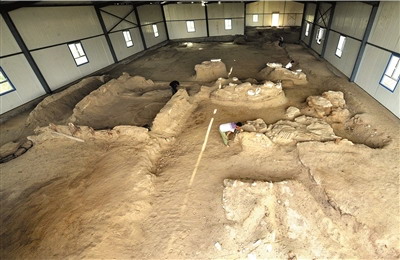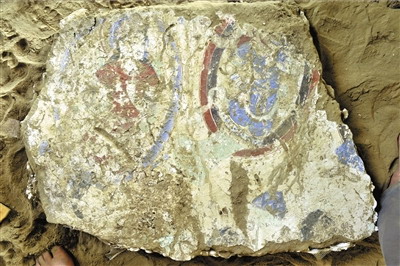26.08.2010

The Xinjiang archaeological team from the Institute of Archaeology under the Chinese Academy of Social Sciences launched archaeological excavations at the Tianfo Site in Damagou Town of Cele County in the city of Hetian, Xinjiang Uighur Autonomous Region on Aug. 22.
According to sources, there are more than 20 important sites of Buddhist architecture distributed in the range of nearly 100 kilometers from south to north along the Damagou river system. The Xinjiang archaeological team has excavated four temple sites in the Damagou Town beginning from 2002 to August 2010. Experts believe Damagou holds the largest number and the largest scale of ancient sites in the best condition in the south region of the Taklimakan Desert.
In the 10th to 11th centuries, the Kingdom of Kashgar, centered on where the current city of Kashgar and Shule County in Xinjiang is located, started a war against its neighboring country, the Kingdom of Khotan, centered on where the city of Hetian in Xinjiang is located. The Kingdom of Khotan, where Buddhism was the predominant religion, was destroyed.
More than 1,000 years later, archaeologists discovered sites of Buddhist temples in the desert region of the southern Damagou Town in Cele County of Hetian region, Xinjiang Uygur Autonomous Region.
Damagou is 30 kilometers away from the east of Cele County. The experts of the Xinjiang archaeological team are cleaning the sites of Buddhist temples in the desert region in front of the Kunlun Mountains.

“The discovery and archaeological excavations of the temple sites in the south region of Damagou began in 2002 and most sites we excavated were established during the period from the sixth century to the eighth century,” said Dr. Wu Xinhua, leader of the Xinjiang archaeological team.
Archaeologists have proven that more than 20 major settlement buildings and Buddhist building sites from the Han and Tang dynasties were widely distributed in an area of about 100 square kilometers along the north-to-south Damagou water system to the Dandan-Uiliq ancient city (located in the middle of the Taklimakan Desert, 70 kilometers north of the county town of Cele County). Among them, a dozen large Buddhist temple site groups each made up of several Buddhist temple building remain.
From 2002 through August of 2010, the archaeological team in Xinjiang, led by Wu, had successively excavated a few Buddhist temple sites and named them as Damagou Tuopulukedun Buddhist Temple Site No.1, 2 and 3.
The Damagou Tuopulukedun Buddhist Temple Site No.1 faces south and has a rectangular structure. It is 2 meters long from north to south and 1.7 meters wide from west to east, with Buddha statues placed close to the north wall.
Wu said he believes that this Buddhist temple is the smallest among all discovered Buddhist temples in the Middle Ages across China and even the entire world. The temple’s small size allowed it to be fully covered by tamarisk, and it has the most intact Buddha hall of all discovered Buddhist temples in China’s Taklimakan Desert areas. Despite its small size, the temple has exquisite frescoes, with the largest combined area among all frescoes in Buddhist temples in that area.
Source: People’s Daily Online




